Creation Museum (part 3)
“Many women who do not dress modestly … lead young men astray, corrupt their chastity and spread adultery in society, which increases earthquakes.”
—Hojatoleslam Kazem Sedighi, cleric

And now we come to Part Three of the series, wherein we learn of the Great Flood and Noah’s Ark.
In Part Two, we saw the Garden of Eden, and learned the lesson of not eating from the wrong tree. The last we saw of Eve, she was barefoot and pregnant while Adam was out working for a living.
Sadly, that wasn’t enough to make people behave well. In fact, they behaved so badly that God decided to kill them all. You know the rest: he told Noah to build a big boat.
There is one thing here I found surprising: I thought the contention was that the dinosaurs became extinct because they didn’t get tickets for the Ark. (Because they were too big, or too dangerous, or no one liked them, or whatever.) But, no—dinosaurs were on the Ark. The Bible says “all,” not “all but the dinosaurs,” and that’s that: T-Rex on the Ark.
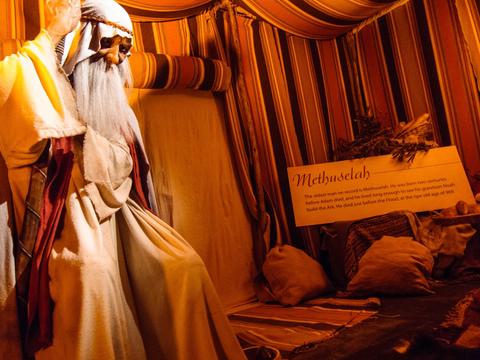
But we begin with Methuselah. Methuselah is the oldest person on record, having lived to be nine hundred sixty-nine years old. He died seven days before the Flood.
Recall that Noah was six hundred years old at the time of the Flood, and lived another three hundred fifty years thereafter. He missed the record by a mere nineteen years.
The human lifespan has dropped by ninety percent in a few thousand years. The Museum offers no explanation for this alarming development. (Note from several years later: the Ark Encounter explains this, sort of.)

These folks are sitting around laughing at what a moron Noah is for building a huge boat nowhere near any water. Of course, we know the joke is on them.
This part of the story always strikes me as particularly cruel. Noah was told by God that the world was to be destroyed in a flood: of course he believed it. Everyone else was told this by a crazy old dude building a boat miles from any water. You wouldn’t believe him, either.
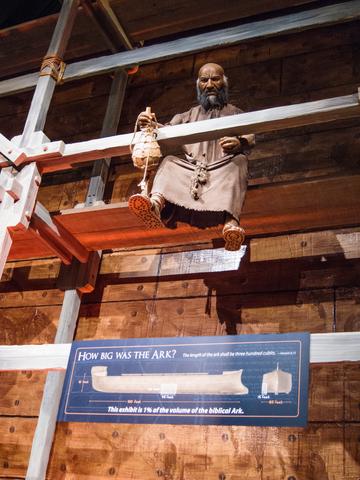
Here’s Noah, having a cold one after a hard day of Ark building.
The Ark was five hundred ten feet long, slightly shorter than a Ticonderoga class guided missile cruiser, eighty-five feet wide, and fifty-one feet tall. So, for his time, Noah was one heck of a ship builder.
A Ticonderoga class cruiser carries a crew of about four hundred, and that’s Navy-style accommodations with tiny bunks. Somehow, Noah had to fit two of every animal on that thing. Including Tyrannosaurus rex.

A cutaway model of the Ark.
The quality of the Ark models is really quite impressive.
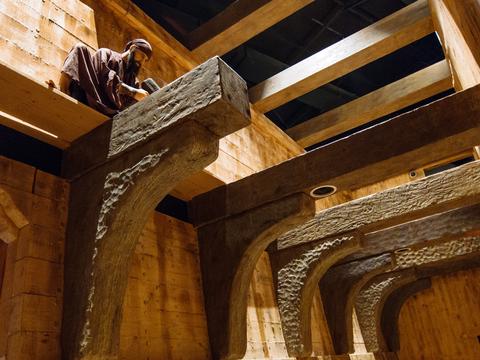
This isn’t camera-angle trickery: this is a life-size Ark segment you can walk through.
It makes the Ark seem very large—but large enough to fit everything that needed to fit?
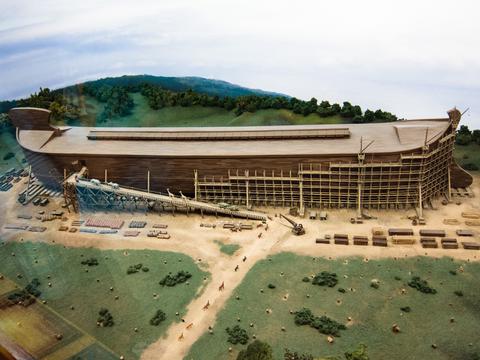 Here, we have the animals boarding the Ark in an orderly fashion.
Here, we have the animals boarding the Ark in an orderly fashion.
Why do depictions of this scene always feature giraffes and elephants? Never the earthworms or opossums?
The question of how Noah could have rounded up all these animals and gotten them to coöperate by boarding the Ark has a simple answer: God brought the animals to Noah, so Noah didn’t have to do that himself.
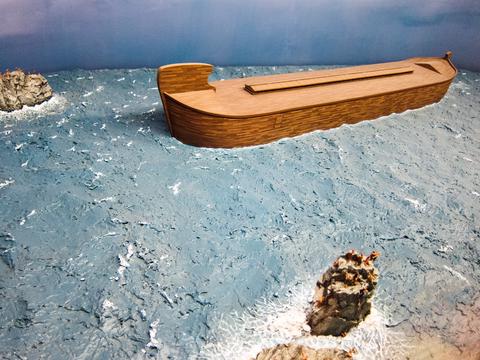
And the water rose, and the Ark set sail (figuratively; there were no sails on the Ark).
Apparently, building the Ark on high ground enabled it to survive the onset of the Flood. By the time it was set afloat, the initial ravages of the rising water, and the ensuing tsunamis, were over with, and the ship could avoid crashing into mountains or anything else that might damage it.
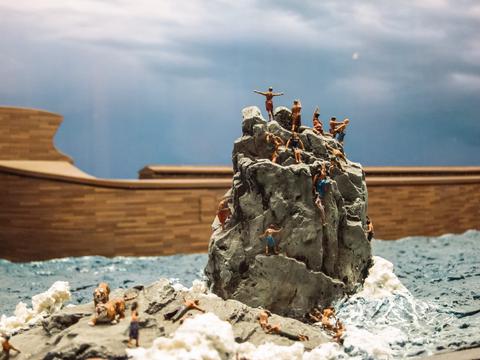
“Ha ha, suckers! No ark for you!”
Here we see victims of the First Genocide, desperately clawing their way to higher ground, pleading to be allowed onto the Ark. Noah sails away in his floating petting zoo, laughing, as millions die around him.
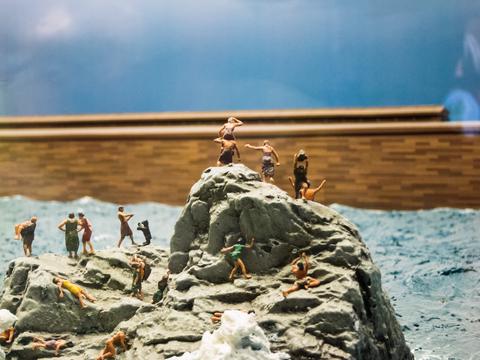
What a horrifying scene to subject children to. After this, won’t they need further indoctrination to convince them that this God is capable of any love at all?
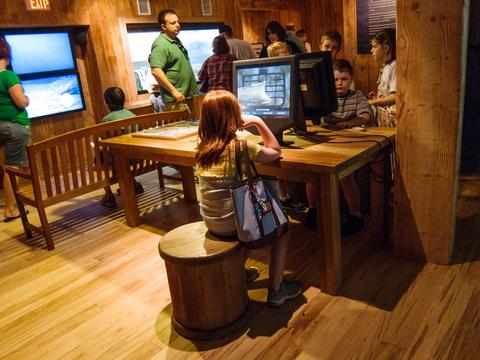
Luckily, indoctrination stations are mere steps away.

Got some tough questions you’d like to ask Noah? Meet Interactive Noah: he moves and talks and answers your questions about the Ark! Naturally, he doesn’t answer just any question; there is a list of pre-defined questions you can choose from on a touchscreen monitor. We can’t have people making up their own questions!
One of the questions is the Big One, the one about fitting all those animals on the Ark. This is where the museum’s concept of animal “kinds” comes into play. The contention is that all the variety of animal life can be reduced to a small number of “kinds,” and you only need two of any “kind” because the variety is pre-programmed into the DNA of all “kind” members.
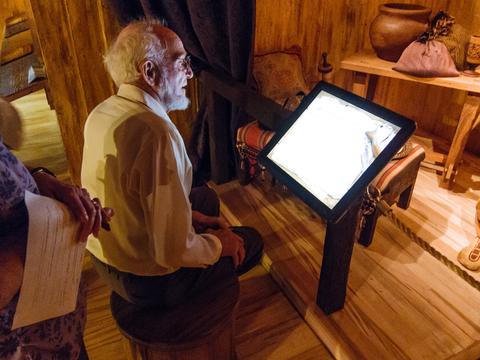
Thus, you need only two dogs, and those dogs will automatically produce all the various dog breeds as well as wolves and coyotes very quickly. Horses and zebras? Same “kind,” so you don’t need both.
The entire animal kingdom is reduced to only a couple hundred of these “kinds,” which makes it possible for them all to fit on the Ark.
No scientific evidence is presented for this notion of “kinds.” It’s stated as though it were an established idea.

Noah’s family tends the animals on the Ark.
The sanitation problem alone must have been overwhelming. I guess you could just throw the “waste” overboard. But they didn’t know about germs back then. Maybe they just got lucky.
They were stuck on that boat for months, so they needed to bring months of food for all those animals—without knowing beforehand how long they would be on the Ark.
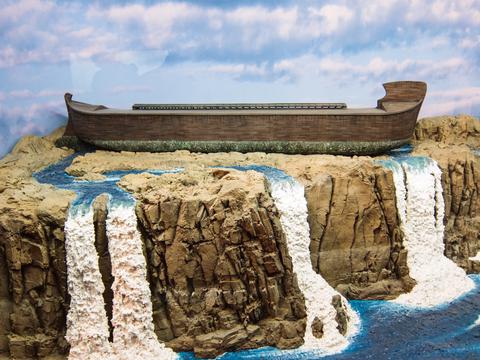
The water recedes, and the Ark comes to rest on the mountains of Ararat.
Biblical literalists continue to scour these mountains for remains of the Ark. Unfortunately they don’t know exactly which mountain it was, and they haven’t found anything yet.
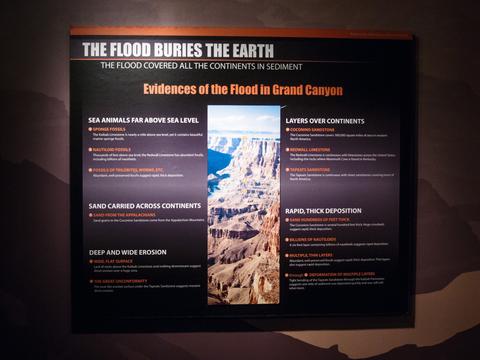
The Flood is taken to explain all sorts of things, from fossils to the Grand Canyon.
All the fossils we find today were buried at the same time, by the Flood. There was so much water that everything came to rest in all the various layers of earth, the layers scientists have determined were created over millions of years.
The existence of fossils of sea animals above sea level is taken as evidence of this, rather than shifting continents and changing seas.
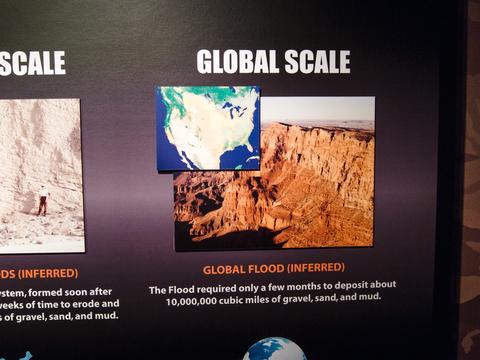
The Grand Canyon, the museum insists, was created in a matter of weeks by the waters of the Flood.
The evidence: flowing water in a rain storm can create tiny “canyons” in the mud in a very short time—so, obviously, all it takes to create the Grand Canyon that quickly is more water.
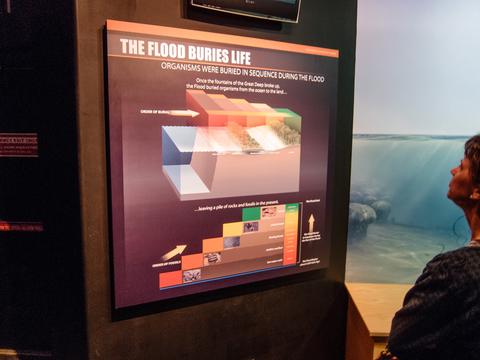
Geological layers are really just a result of the Flood burying everything in a very short period of time.
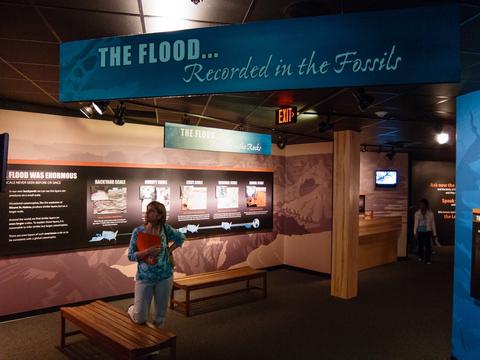
Nevermind science—you’ve seen rain erode mud in your own back yard, so obviously the Grand Canyon is the same thing.
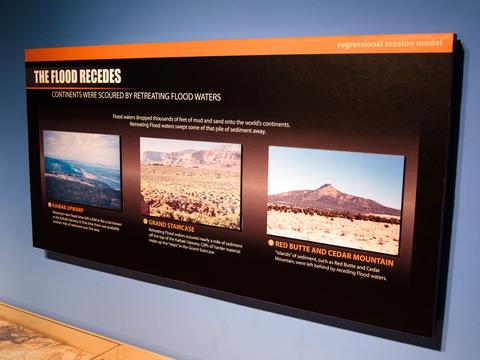
The physical features of the continents that weren’t created by the Flood are explained by the receding waters of the flood washing away excess sediment and carving out natural features of the landscape—again, in a matter of days or weeks.

Darwinian natural selection is presented as a misunderstood concept that couldn’t possibly result in organisms evolving into very different animals, because that’s not possible. The animal “kinds” are what they are, and they can change and adapt within their “kind” but not beyond that.
Horses to zebras? Sure. Dinosaurs to birds? Nope. Apes to humans? No way—humans aren’t even part of a “kind.”
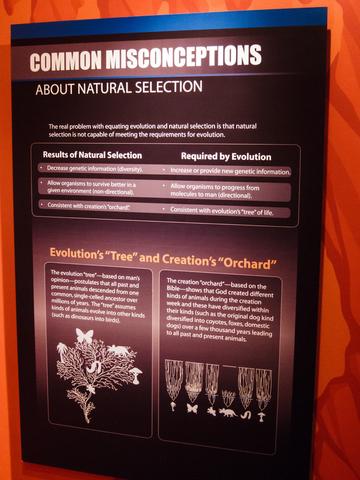
Natural selection, the story goes, doesn’t have the qualities required for the idea of “evolution.” And, of course, evolution is merely an opinion, rather than a scientifically demonstrated theory.
Of course, the problem is that people fail, willfully or otherwise, to understand what the word “theory” means in science. So, they derisively dismiss evolution as “just a theory” without understanding the absurdity of what they’re saying. Gravity is “just a theory,” too: ignore it at your peril.
The notion of a “tree” of evolution of life is just man’s opinion, while the Bible’s “orchard” results in these “kinds” of animals that can only diversify to a certain degree.
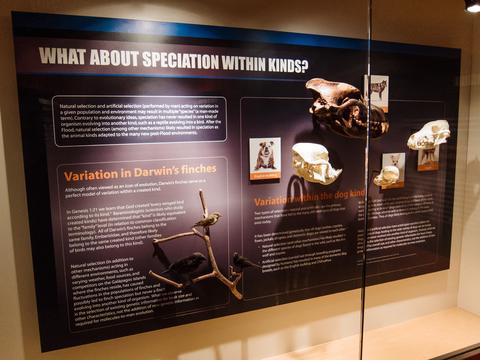
Classification of animals into “species” is dismissed as a man-made idea, as if this “kind” bollocks isn’t.
And here we end Part Three. Check back soon for the fourth and final installment of this Creation Museum visit, which, naturally, will contain lots and lots of dinosaurs.
Note from several years later: Answers in Genesis now has the Ark Encounter, which explains all of this stuff in excruciating detail, and is also worth a visit.